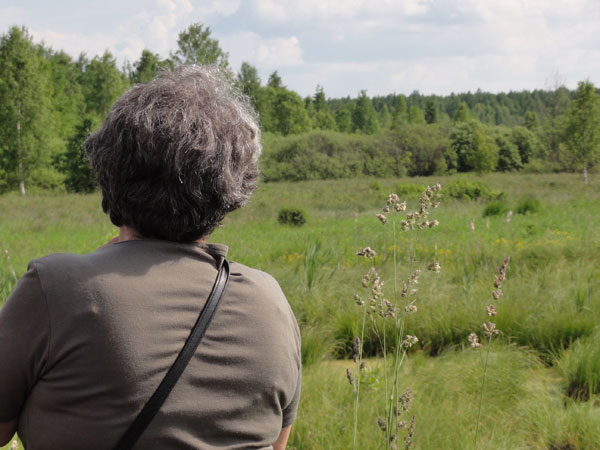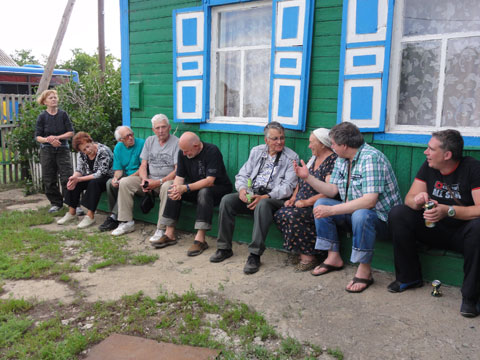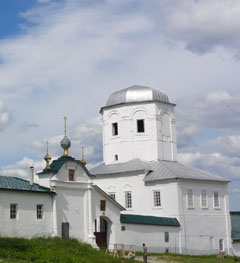
Group member and former deportee Eleonora looks at the site of Vyatlag Camp No. 4, the most likely place where her father died. (Photo by Amanda Jātniece)
Our bus stopped suddenly on the side of the only road leading out of the time-warp village of Lesnoy just west of the Ural Mountains in Russia. We piled out of the bus and our guide told us that this was the site of Vyatlag Camp No. 4, one of the hard labor camps of the notorious Soviet Gulag system in the 1940s and 1950s.
This came as a bit of a surprise, because we had already been shown the site of Camp No. 7 (burned out logs and blocks of cement in tall grass and lush young forest several kilometers outside of town). We didn’t believe the authorities would also show us a second camp site.
But I noticed 80-year-old Eleonora’s gaze never left the meadow on the right side of the road for the entire 10 minutes of our stop. The guide had said that the camp’s cemetery was somewhere in that meadow.
We have all read the eyewitness accounts or at least heard of the hard labor camps and know that they didn’t have anything as dignified as a cemetery. Bodies were usually just thrown into pits—there were so many of them, the ground was frozen for half the year, and no one had the energy to think about last rites, even if such a thing had been allowed.
In any case, this is most likely the spot where Eleonora’s father lies.
* * *
What brought me—and Eleonora—to this part of the world was a woman named Dzintra Geka. That, and my job as a translator.
Geka, a filmmaker in Latvia and the daughter of a man exiled to Siberia, has made it her mission to document the life stories of people who were deported from Latvia to Siberia as children during Stalin’s deportation campaigns of 1941 and 1949. Her Children of Siberia foundation has located and interviewed former deportees, made films about their plight, and now also published a 1,180-page book containing their life stories. Geka has traveled to Siberia many times to meet former deportees and to visit sites where they lived and died.
I was one of three translators involved in translating the above-mentioned tome of deportee life stories from Latvian to English. Even though the work was emotionally difficult, I enjoyed it immensely and found myself very caught up in the stories and the people themselves. After much research regarding terminology and geography and tangents to satisfy my own curiosity, I became determined to see Siberia firsthand.
So I jumped at the opportunity to travel with Geka during the summer of 2011. In fact, our group spent only the first three days in Siberia proper, in Omsk District. After that we road-tripped by aging bus to the Ural Mountains and farther west, because the focus of this trip was the men’s labor camps in Solikamsk and Lesnoy, called Usollag and Vyatlag, respectively.
Most of my almost 30 fellow travelers had a very personal connection to these two places—their own fathers or grandfathers had been imprisoned and died in these camps.
I should add that not all former deportees wish to return to the places where they lived or to see the places where their fathers died. Many are indeed repulsed by the thought.
“I was sent there by force, but you’re going to go willingly?!” said one man to his grandson who accompanied us. Some people are still genuinely afraid of unpredictable Russia. Others just cannot understand the pull of traveling back to the Soviet Union.
Russia is huge and imposing—I liken it to staring down the runway of a major airport—and this is one of its draws. Its natural environment, where it hasn’t been raped, is certainly wondrous. On a smaller scale, its old churches are pretty and its sunken log houses with ornately carved window frames and blue accents are charming in a ramshackle sort of way.
But in general Russia’s human-created environment is not beautiful. Soviet-era concrete architecture and a certain careless attitude to both public and personal space dominate most populated areas. Of course, Moscow, St. Petersburg and Yekaterinburg are shining modern cities. But if one travels across the country, especially off the beaten path, one sees behind the proverbial Potemkin façade.
Traveling off that path is not so simple, especially to regions that still have active prisons, such as Solikamsk and Kirov Province (site of the Vyatlag camps). Geka and her assistant spent many frustrating hours obtaining the necessary permits for our group and still, at the last minute, were informed that, supposedly due to small inconsistencies in the spelling of some surnames, we would not be allowed access to death certificates, court proceedings and other documents relating to our fathers and grandfathers. Considered an official delegation, our group was pleasantly welcomed and very well minded by the authorities, but tour guides nevertheless touted the official line that deportations had been necessary for the development of Russia as a modern nation.
Apart from the usual quirks, rude attitudes, lingering Soviet atmosphere and differing standards of living, though, I think we saw a surprisingly (for a biased Latvian) civilized side of Russia. But then again, we traveled through a relatively civilized part of Russia.
* * *
Eleonora was deported from Latvia in 1941 at age 10 with her mother and father. They had no idea where they were being taken and no time to pack any belongings. All they had along were two bicycles (go figure) and a small bag.
Like all the men, Eleonora’s father was separated from his family at the train station in Latvia, and she never saw him again. He was sent to the hard labor camps in Kirov Province, while Eleonora and her mother were exiled to a small village much farther into Siberia. By spring they were reduced to digging up frozen leftover potatoes from the field. Only three of the 11 families exiled to that village survived.
Eleonora returned to Latvia in 1961, a single mother with two children. Only much later did she find out that her father, who had worked as a border guard in Latvia, had been sentenced to death in January 1942 at age 36. Eleonora’s daughter recently died, and she is now the primary caregiver for her ill grandson. But mostly, she feels sorry for her father and what he had to endure.
Eleonora still has many questions regarding her father’s last months and death, questions that will never be answered. The 10 minutes our bus stopped on the side of this road must suffice for the rest of her life. But at least now, whenever she prays and thinks of her father, it will be this field that she remembers. Now at least she can point her grief at a specific place.

Group members visit with a local woman (third from right) in Drobishevo, Russia. (Photo by Amanda Jātniece)

Local women in Drobishevo, Russia, pause to examine the tour group from Latvia. (Photo by Amanda Jātniece)

The monastery in Solikamsk, Russia, was used as a prison during the first half of the 20th century. (Photo by Amanda Jātniece)



